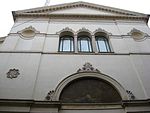Pedrocchi Café
Buildings and structures in PaduaCoffeehouses and cafés in ItalyGothic Revival architecture in ItalyTourist attractions in Veneto

The Pedrocchi Café (Caffè Pedrocchi in Italian) is a café founded in the 18th century in central Padua, Italy. It has architectural prominence because its rooms were decorated in diverse styles, arranged in an eclectic ensemble by the architect Giuseppe Jappelli. The café has historical prominence because of its role in the 1848 riots against the Habsburg monarchy, as well as for being an attraction for artists over the last century from the French novelist Stendhal to Lord Byron to the Italian writer Dario Fo.
Excerpt from the Wikipedia article Pedrocchi Café (License: CC BY-SA 3.0, Authors, Images).Pedrocchi Café
Piazzetta Cappellato Pedrocchi, Padua San Giuseppe
Geographical coordinates (GPS) Address Nearby Places Show on map
Geographical coordinates (GPS)
| Latitude | Longitude |
|---|---|
| N 45.407777777778 ° | E 11.877222222222 ° |
Address
Zara
Piazzetta Cappellato Pedrocchi 17
35138 Padua, San Giuseppe
Veneto, Italy
Open on Google Maps








